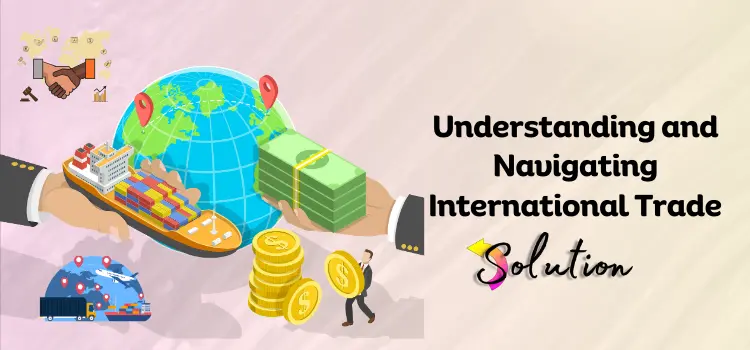
International trade is like the glue that holds our global economy together, allowing businesses and customers to connect worldwide. It’s all about countries trading goods, services, and money based on what they’re best at making or providing. Imagine it as a vast marketplace that facilitates the buying and selling of everything from clothes and electronics to food and resources.
To understand how countries buy and sell goods with each other, you need to know about rules for importing and exporting, taxes on imports, deals between countries, and the value of different currencies. These factors all play a role in how businesses operate worldwide and impact things like what products are available and how economies grow.
Learn how to successfully navigate the complex world of international trade with our blog, where we simplify key concepts and provide valuable insights for businesses and individuals looking to expand their global reach. Are you curious about how global markets work? Join us on a journey to gain valuable insights into the dynamics of the international economy. Let’s delve into the world of international trade and learn how to navigate this important aspect of our modern world.
A Brief on International Trade: An Engine of Economic Growth
International trade involves the buying and selling of goods, services, and money between countries. This happens because each country has different resources, costs, and demands that drive their trade activities. In today’s global economy, countries can specialize in what they do best, leading to increased efficiency and growth worldwide. With advancements in technology and supply chain management, companies can now seamlessly operate on a global scale, designing, manufacturing, and selling products across borders.
International trade involves various elements, such as trade policies, tariffs, exchange rates, and agreements between countries. For instance, Japan may sell advanced electronics to the United States and buy agricultural products in return. This exchange is mutually advantageous, as it enables both countries to capitalize on their respective strengths. It is important for businesses, policymakers, and consumers to understand how international trade works in today’s interconnected world.
Recent Post:- How to Read and Interpret Financial Ratios?
What are the Benefits of International Trade?
Here are some benefits of international trade that you should be aware of to deepen your understanding of the topic. Recognizing these advantages allows you to gain valuable insights into how global trade can positively impact economies and businesses around the world.
- Multiplies the economic growth: International trade helps countries grow their economies by creating more opportunities to sell goods and services in new markets. For example, China’s economy has grown rapidly by focusing on exporting manufactured goods. Increasing trade can provide countries with new opportunities to expand their enterprises and increase their income.
- Inflate competition and innovation: When companies compete in international markets, they are motivated to come up with new ideas and make their products better to attract customers. This is why the global smartphone market is always evolving as companies strive to offer the best features and gain more customers. So, keep innovating your ideas to increase your chances of success in the market.
- Lower prices and greater variety for consumers: When countries trade with each other, it can lead to lower prices for consumers because of more competition and the ability to produce goods on a larger scale. This means that people can enjoy a wider range of products from around the world, such as the ability to buy and try different foods or items that are not typically available in their own country.
- Job creation and skill development: International trade can lead to job losses in some industries, but it also opens up new opportunities in sectors that focus on exporting goods and services. This helps workers develop new skills to meet the demands of the global market. For example, India’s IT services industry has seen significant growth, creating millions of highly skilled jobs for its workforce.
- Transfer of technology & improved international relations: International trade helps countries share technology and knowledge, which can make production more efficient and increase productivity. It also strengthens diplomatic relationships between nations, potentially reducing the chances of conflicts due to economic interdependence.
- Efficient resource allocation: By focusing on what they do best, countries can make the most of their resources and boost productivity worldwide. For example, New Zealand excels in dairy exports thanks to its ideal climate and advanced farming techniques.
What are the Criticisms of International Trade?
Learn about the drawbacks of international trade by exploring the following points. It’s important to consider both the benefits and challenges before engaging in global commerce.
- Job Displacement and Wage Suppression: Many critics believe that international trade can cause job losses in developed countries, especially in manufacturing. When companies outsource to places with cheaper labor, they can keep wages low or even decrease them in certain industries. This can worsen income inequality and create economic gaps within a country.
- Environmental Concerns: Global trade can harm the environment by increasing production and transportation, leading to more carbon emissions and the exploitation of lax regulations. This can also speed up the depletion of natural resources and the destruction of habitats in areas focused on exporting goods.
- Economic Dependence and Vulnerability: Overreliance on foreign commerce can expose national economies to global economic volatility and external shocks. Developing countries may become unduly reliant on exporting raw materials or specific commodities, limiting their ability to diversify their economies. This dependence could lead to economic instability if global demand or prices for these products change.
- Cultural Homogenization: Critics say that the proliferation of global brands and products through international trade may result in a loss of cultural diversity. Local businesses and traditional products may struggle to compete with global firms, thus undermining cultural identities.
- Exploitation of Labor in Developing Countries: There are concerns that international firms may exploit workers in nations with lower labor standards. International commerce frequently identifies poor working conditions, low salaries, and child labor as negative outcomes.
- Trade Imbalances and Economic Dominance: Persistent trade imbalances can cause economic tensions among nations. Critics claim that rich economies might exploit trade to retain economic dominance over underdeveloped countries, prolonging global inequity.
These objections underscore the complexities of international commerce and the importance of carefully considering its effects on many economic, social, and environmental factors.
How Can Businesses Use International Trade for Success?
Business owners can leverage international trade to enhance their company’s growth and resilience by strategically expanding their market reach and diversifying their supply chains. To begin, conducting thorough market research is essential to identifying potential overseas customers and understanding their needs and preferences. This knowledge allows for tailored product offerings and marketing strategies. Establishing relationships with reliable international partners, such as distributors or agents, can facilitate market entry and help navigate local business practices.
Businesses should also consider diversifying their supplier base across different countries to mitigate risks associated with geopolitical issues, natural disasters, or economic fluctuations in a single region. This approach can ensure a more stable supply chain and potentially reduce costs through competitive sourcing. Adding to this, utilizing free trade agreements and understanding tariff structures can lead to cost savings and competitive pricing in foreign markets. Additionally, investing in digital infrastructure for e-commerce can open up direct-to-consumer channels globally.
To manage currency risks, implementing hedging strategies or setting up multi-currency accounts can be beneficial. It’s also crucial to stay informed about international trade regulations, intellectual property laws, and cultural nuances in target markets. By carefully planning and executing an international trade strategy, business owners can not only secure their operations against domestic market fluctuations but also tap into new growth opportunities, ultimately achieving greater success and long-term sustainability.
Also Read:- Nvidia’s Stock Soars
End Note!
In conclusion, international trade is a complex and dynamic system that underpins our global economy. While it offers significant benefits such as economic growth, increased competition, and wider consumer choice, it also faces criticisms regarding job displacement, environmental concerns, and potential exploitation. Understanding both the advantages and drawbacks of international trade is crucial for businesses, policymakers, and individuals in our interconnected world. For businesses looking to leverage international trade for growth, one key tip is to thoroughly research target markets and regulations before expanding. By carefully assessing opportunities and challenges in foreign markets, companies can develop strategies that maximize the benefits of international trade while mitigating potential risks.


